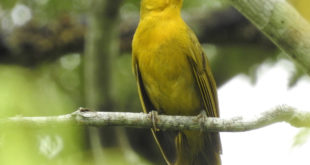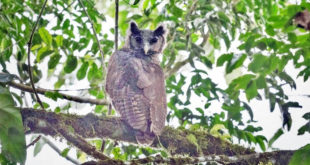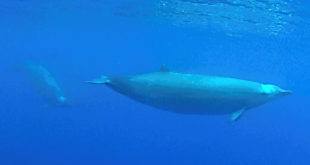Ornithologists have discovered a new genus and species of tanager on the lower slopes of the Andes in southeastern Peru and western Bolivia. The Inti tanager (Heliothraupis oneilli). Image credit: Louisiana State University / Lane et al., doi: 10.1093/ornithology/ukab059. Tanagers are a large family, Thraupidae, of more than 370 songbird …
Read More »Rare Shelley’s Eagle Owl
The Shelley’s eagle owl (Bubo shelleyi) was photographed by Imperial College London researcher Joseph Tobias and freelance ecologist Robert Williams on October 16, 2021 in Ghana. The Shelley’s eagle owl (Bubo shelleyi). Image credit: Robert Williams. The Shelley’s eagle owl is a large species of owl found in the rainforests …
Read More »New Type of Neuron
Cell classes are the building blocks for the central nervous system. It is widely believed that major classes of neurons have been identified in the retina, although some types have not been fully characterized. The newly-discovered retinal neurons don’t fit into any existing mammalian retinal cell class. An image of …
Read More »New Beaked Whale
The newly-identified species, named the Ramari’s beaked whale (Mesoplodon eueu), occurs throughout temperate southern hemisphere waters, with reports from several locations off South Africa, Australia, and Aotearoa New Zealand. True’s beaked whales (Mesoplodon mirus). Image credit: Roland Edler, Duisburg Zoo. “The Earth’s deep ocean remains less understood than the surface …
Read More »Tardigrade Fossil Discovered
Again with the accidental discoveries! It’s the third unexpected find within six weeks. This time, the good news was born from debris in a hunk of Dominican amber. The researchers were studying ants from the Miocene period, trapped in a piece of amber. A closer look at the “debris” inclusions, …
Read More »Red Blood Cells
A team of biologists from the University of Surrey, the MRC Laboratory for Molecular Biology, Wake Forest University and the École Centrale de Lyon has discovered that red blood cells generate an electric field voltage that appears outside and not just within, meaning each cell acts as a tiny electrode. …
Read More »Oxygenic Photosynthesis
Using a new gene-analyzing technique, researchers from MIT and elsewhere have found that all extant species of cyanobacteria can be traced back to a common ancestor that evolved around 2.9 billion years ago. They’ve also found that the ancestors of cyanobacteria branched off from other bacteria around 3.4 billion years …
Read More »Cats Hunt Wild Prey
Predation of wildlife by domestic cats (Felis catus) presents a threat to biodiversity conservation in some ecological contexts. The proportions of wild prey captured and eaten by domestic cats and thus the contributions of wild prey to cat diets are hard to quantify. In a new study published in the …
Read More »Freshwater Crayfish
Scientists have described a new species of the crayfish genus Cherax from the Murray-Darling Basin in eastern Australia. The swamp yabby (Cherax latimanus). Image credit: McCormack & Raadik, doi: 10.11646/zootaxa.5026.3.2. Cherax is the most widespread genus of fully aquatic crayfish in the southern hemisphere. Commonly known as yabbies, members of …
Read More »Vampire Bats
During nightly foraging trips, closely bonded females of common vampire bats (Desmodus rotundus) depart their roost separately, but often reunite far outside the roost to hunt together, says a new paper published today in the journal PLoS Biology. The common vampire bats (Desmodus rotundus). Image credit: Uwe Schmidt. Vampire bats …
Read More » #Bizwhiznetwork.com Innovation ΛI |Technology News
#Bizwhiznetwork.com Innovation ΛI |Technology News









